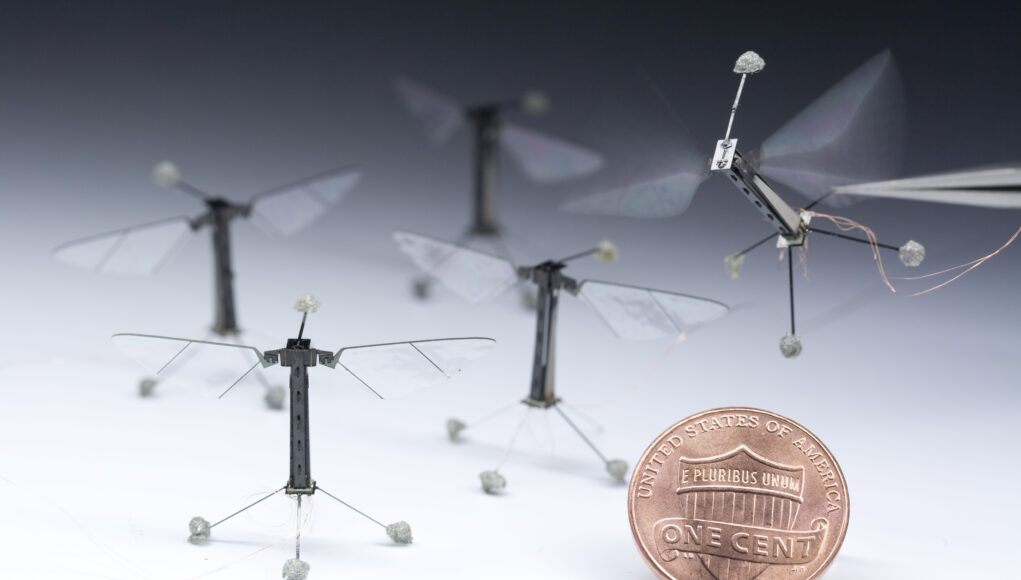The RoboBee lives.
Not only does it fly, dive, hover, and mimic the shrimp from hell, but now the tiny bastard can land without crashing like a drunken moth on a death trip.
It’s true. This half-gram harbinger of the synthetic insect apocalypse, spawned from the mad labs of Harvard’s Robert Wood, has finally figured out how to stick the landing—a feat as harrowing in micro-robotics as walking a tightrope across the Grand Canyon during an acid storm.
Years ago, RoboBee buzzed onto the scene, a freak of nature and machine, a twitching carbon-fiber Frankenstein no bigger than a paperclip. Tethered like a junkie to life support, it fluttered and fought against gravity’s tyranny, chasing the roboticist’s white whale: sustained, untethered flight at the scale of an insect.
You might think that’d be easy—hell, flies do it all the time—but at this scale, a single breeze becomes a hurricane, and a bad landing? Catastrophic.
RoboBee’s Leap Toward Earth
Until recently, the RoboBee could do everything but land without looking like a helicopter crashing into a hay bale. “We used to just kill the power and let it drop,” said Christian Chan, a wide-eyed grad student who probably hasn’t slept in four years. “Then we’d pray.”
But prayer is no substitute for biomechanics, and salvation came in the form of the crane fly—nature’s gangly, leggy idiot savant. Its wiry limbs, as it turns out, are perfect shock absorbers.
Inspired, Wood’s crew grafted similar leg designs onto RoboBee, turning this flighty little demon into a sci-fi gymnast, capable of gracefully touching down on leaves, branches, or whatever godforsaken perch awaits.
To test it, they tossed RoboBee like a lawn dart and filmed the carnage in glorious high-speed video. They shook its legs, they measured the oscillations, they watched it bounce like a caffeinated flea on a trampoline.
Eventually, what emerged was something close to miraculous: an insect-scale robot capable of controlled descent and multi-point landing with spring-damper legs tuned like a Swiss watch.
Want the gritty details? Check the paper in Science Robotics, where equations dance like voodoo spells.
The Bigger Picture: Insect Armageddon, but Make It Useful
Let’s not kid ourselves: this isn’t just about watching RoboBee do a tightrope act on a flower petal. This is about swarms. Thousands—maybe millions—of flying micro-automatons that could monitor ecosystems, replace dying pollinators, or spy on you in your backyard wearing tiny GoPros.
It’s a terrifying and glorious future, and the first step is making sure these little suckers don’t shatter their legs every time they land.
And it’s only going to get weirder. The team is now eyeing stingless bees, mosquitoes, and even mantis shrimp (yes, the punchy little bastards with claws like jackhammers) for biomechanical inspiration.
They’ve already built one that mimics that shrimp’s uppercut, by the way—because why not?
But Wait, It’s Still Tethered…
Yes, RoboBee still needs an off-board brain and power source, like a toddler in a bungee harness. But the path to autonomy is clear, and every time it lands like a pro, it’s one step closer to cutting the cord. The tethers are a prison. The landing gear? A key.
Wood’s dream is a fully autonomous bug-bot, flitting through disaster zones, sampling polluted air, or (god help us) pollinating your tomatoes when the bees finally give up. It’s a noble dream—equal parts sci-fi salvation and cyberpunk nightmare.
Curious about how far this rabbit hole goes? Take a detour through Harvard’s Wyss Institute and brace yourself.
In Summary:
The RoboBee has evolved—from a twitchy prototype with a death wish to a delicate, air-dancing marvel of biomimetic engineering. And all it took was some high-speed footage, a crash-test dummy army, and inspiration from one of nature’s dumbest flyers.
Godspeed, little robot.
Let’s just hope it’s on our side when the swarm comes.












